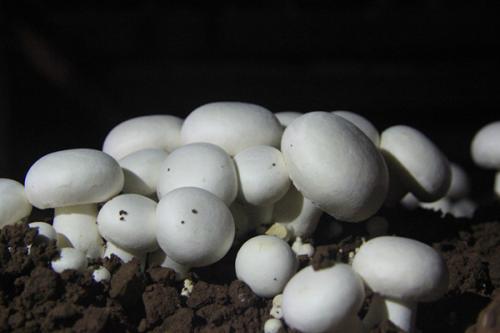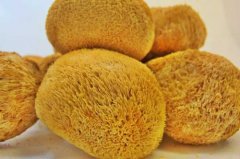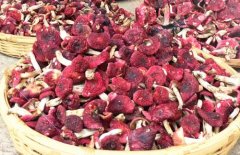New cultivation techniques of Agaricus bisporus: what is Agaricus bisporus? Is Agaricus bisporus a mushroom?
Do you know what kind of mushroom Agaricus bisporus is? Agaricus bisporus, commonly known as Pleurotus ostreatus, is one of the most common edible mushrooms and fleshy. Is Agaricus bisporus a mushroom? No, they are two different strains, but they are a little similar in appearance. What are the new cultivation techniques of Agaricus bisporus?

1. Cultivation season. The temperature range of Agaricus bisporus is from 10 ℃ to 28 ℃. It can be cultivated in spring and autumn, but it is better in autumn, and it is the best from the end of August to the first ten days of October in the Central Plains.
2. Material preparation. Corn stalks (including newly harvested corn stalks or last year's mildew-free corn stalks) were chopped into segments about 30 cm long and fermented. The formula is: 500 kg of corn stalk, 100 kg of dried chicken manure, 25 kg of cottonseed cake, 2.5 kg of urea, 15 kg of phosphate fertilizer and 12.5 kg of lime.
3. Build a pile for fermentation. Soak the corn stalks with 2% lime water, mix well and ferment for 2 days, the composting temperature reaches 60 ℃. Then the material soaked in water will be built according to the width of 2 meters, height of 1.8 meters, unlimited length. First spread 20 cm thick cornstalk, then sprinkle 3 cm-5 cm thick chicken dung, water once, then spread a layer of material, sprinkle once dung, water once, pay attention to spread dung evenly, water should be fully watered. After the pile is built, cover it with plastic film for heat preservation and moisturization. note that the plastic film should not be covered strictly, so as not to form anaerobic fermentation. It takes about 25 days to ferment according to the conventional method.
4. Inoculation. Spread the fermented material evenly on a pre-prepared border or bed with a width of 80 cm and unlimited length, 20 cm-25 cm thick, flattened, inoculated with a bamboo Jack 5 cm square, 1 bottle / m2-1.5 bottle / m2, and covered with plastic film to keep warm and moisturize to promote mycelium germination. After the mycelium germination, lift the film to increase oxygen every day to promote the mycelium growth, and after about 7 days, the plastic film can be propped up, or the plastic film can be removed and covered with a woven bag on the material surface, which can not only keep moisture, but also ventilate, and create suitable conditions for rapid mycelium growth.
5. Mushrooms are produced by covering the soil. Cover the soil according to the conventional method, disinfect the fine soil that is prepared to cover the soil in advance, adjust the moisture of the sterilized soil (hold it in a ball by hand, and loosen your hand), when the hyphae grow to 1 inch of the thickness of the material, the thickness of the first layer is about 2 cm, and when the hyphae grow to the thickness of 2 cm, the thickness of the second layer of the cover is about 1.5 cm, and pay attention to keep the soil moisture after covering.
6. Management. The focus of the management of autumn mushroom is mainly cooling and moisturizing in the early stage and heat preservation and moisturizing in the later stage. After the mycelium grows full, it is necessary to increase the temperature difference between day and night, but we should also pay attention to maintain the surface humidity and make the mycelium kink, which can be managed for 10-15 days. After the second tide of mushrooms, combined with spraying "Zhuang Mushroom Ling", the yield of fresh mushrooms can be increased. The focus of the management of spring mushroom is to ensure moisture, resist high temperature and control diseases and insect pests. After overwintering, both the culture material and the covering soil are short of water, so it is necessary to spray 0.5% lime water lightly and frequently to restore the growth of mycelium and promote the rapid emergence of mushrooms.
- Prev

Where is the origin of hericium Erinaceus? Where does hericium Erinaceus produce? how to eat hericium Erinaceus to nourish the stomach?
Hericium Erinaceus is a kind of food with high nutritional value, its efficacy and function is very many, the widest understanding of its function is to nourish the stomach, then you know how to eat, the most nourishing stomach? Where do you have monkey mushrooms in China? Where did hericium Erinaceus come from?
- Next

The difference between Pleurotus ostreatus and Pleurotus ostreatus, are there artificial cultivation techniques of Pleurotus ostreatus
Pleurotus ostreatus and Pleurotus ostreatus are very similar, so how to distinguish them? Is Pleurotus ostreatus artificially planted? What is the artificial planting technology of Pleurotus ostreatus? Let's take a look. Pleurotus ostreatus, etc., the fruiting body is generally medium-sized, poisonous red mushroom, also known as vomiting red mushroom, appearance and
Related
- Fuxing push coffee new agricultural production and marketing class: lack of small-scale processing plants
- Jujube rice field leisure farm deep ploughing Yilan for five years to create a space for organic food and play
- Nongyu Farm-A trial of organic papaya for brave women with advanced technology
- Four points for attention in the prevention and control of diseases and insect pests of edible fungi
- How to add nutrient solution to Edible Fungi
- Is there any good way to control edible fungus mites?
- Open Inoculation Technology of Edible Fungi
- Is there any clever way to use fertilizer for edible fungus in winter?
- What agents are used to kill the pathogens of edible fungi in the mushroom shed?
- Rapid drying of Edible Fungi

